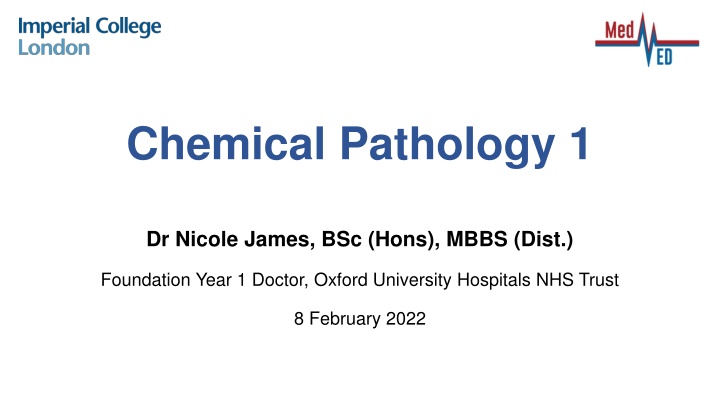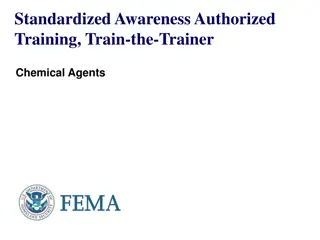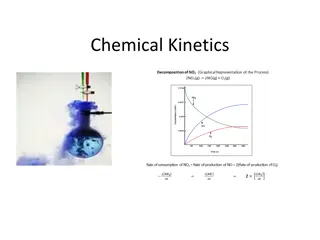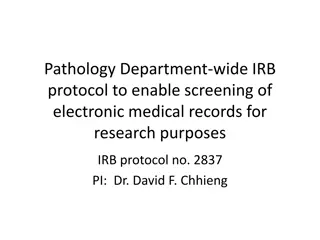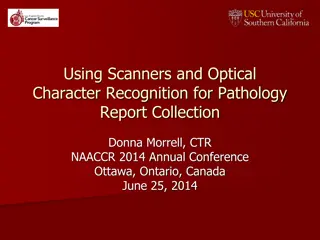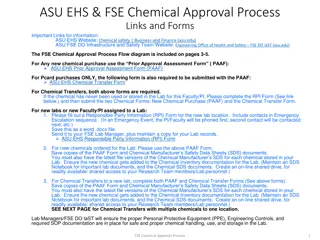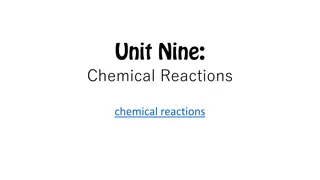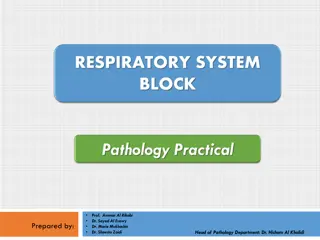Chemical Pathology Insights
Dr. Nicole James provides valuable information on topics such as sodium and fluid balance, potassium, calcium, acid-base balance, and liver function tests. Learn about osmolality vs osmolarity, osmolar gap, sodium regulation, and more in the field of chemical pathology.
Download Presentation

Please find below an Image/Link to download the presentation.
The content on the website is provided AS IS for your information and personal use only. It may not be sold, licensed, or shared on other websites without obtaining consent from the author.If you encounter any issues during the download, it is possible that the publisher has removed the file from their server.
You are allowed to download the files provided on this website for personal or commercial use, subject to the condition that they are used lawfully. All files are the property of their respective owners.
The content on the website is provided AS IS for your information and personal use only. It may not be sold, licensed, or shared on other websites without obtaining consent from the author.
E N D
Presentation Transcript
Chemical Pathology 1 Dr Nicole James, BSc (Hons), MBBS (Dist.) Foundation Year 1 Doctor, Oxford University Hospitals NHS Trust 8 February 2022
Content 1. Sodium and fluid balance 2. Potassium 3. Calcium 4. Acid-base balance 5. Liver function tests
Content 1. Sodium and fluid balance 2. Potassium 3. Calcium 4. Acid-base balance 5. Liver function tests
Osmolality vs Osmolarity Osmolality = mOsm/kg of solvent More accurate Measured by automated lab machine OsmolaRity = mOsm/litRe of solvent More practical Calculated from blood tests
Osmolar gap Calculated osmolality = 2 (Na + K) + glucose + urea = 275 295 mOsmol/kg Measured osmolality calculated osmolality > 10mOsmol/kg Caused by other substances that are not part of the equation: Alcohol: methanol, ethanol Sugars: mannitol, sorbitol Lipids: hypertriglyceridaemia Proteins: hypergammaglobulinaemia
Take home message 1 In practice, we are not bothered about the difference between osmolality and osmolarity. Sodium is the largest contributor to plasma osmolality. 2 (Na + K) + glucose + urea
CPQ 1 Rank the expected calculated osmolality in patients with each of the following outcomes, with 1 being the highest osmolality and 5 being the lowest. Diabetes insipidus Diabetic ketoacidosis Hyperosmolar hyperglycaemic state Pneumonia SIADH
CPQ 1 Rank the expected calculated osmolality in patients with each of the following outcomes, with 1 being the highest osmolality and 5 being the lowest. 1. Hyperosmolar hyperglycaemic state 2. Diabetic ketoacidosis 3. Diabetes insipidus 4. Pneumonia 5. SIADH
Sodium regulation: Blood volume Increased blood volume atrial stretch increased release of atrial natriuretic peptide (ANP) Decreasing release of: Aldosterone (adrenal cortex) ADH (hypothalamus) Renin (kidney) Hence decreasing sodium concentration and blood volume
Sodium regulation: Osmolality High osmolality thirst + ADH release decrease sodium concentration Low osmolality ADH suppression increase sodium concentration Conflict in role of ADH in maintaining blood volume (increase if low) and osmolality (decrease if low) volume more important
Hyponatraemia Step 1 Check plasma osmolality to exclude pseudohyponatraemia (low sodium with normal/high plasma osmolality) Normal osmolality high lipids, proteins High osmolality high sugars, alcohols
True hyponatraemia Low sodium with low plasma osmolality All states of hyponatraemia are due to relative excess of water
True hyponatraemia Step 2 Assess volume status BP, HR, CRT Leg oedema Pulmonary oedema
Hypovolaemic hyponatraemia Hypovolaemic (low total body water) appropriately high ADH Step 3 Check urinary sodium for cause If < 20 mmol/L = extra-renal loss (vomiting, diarrhoea, burns) If > 20 mmol/L = renal loss (renal disease, diuretics, cerebral salt wasting) Management treat underlying cause, IV 0.9% NaCl or slow IV hypertonic 3% NaCl
Hypervolaemic hyponatraemia Hypervolaemic (high total body water) but low effective arterial blood volume Reduced cardiac output: CCF Increased peripheral arterial vasodilation: cirrhosis Step 3 Check urinary sodium for cause If < 20 mmol/L = CCF, cirrhosis, nephrotic syndrome If > 20 mmol/L = CKD Management treat underlying cause, fluid restrict
Euvolaemic hyponatraemia Increased total body water relative to sodium Step 3 Check urinary sodium for cause If < 20 mmol/L = psychogenic polydipsia, tea and toast diet If > 20 mmol/L = hypothyroidism, adrenal insufficiency, SIADH Management treat underlying cause, fluid restrict, demeclocycline or tolvaptan for resistant SIADH
Diagnosing SIADH Causes brain, lung, pills Diagnosis of exclusion check TFTs and cortisol levels first Diagnostic criteria Low plasma sodium (< 135) Low plasma osmolality (< 270) High urinary sodium (> 20) High urinary osmolality (> 100) No adrenal/thyroid/renal dysfunction
Take home message 2 Hyponatraemia is a water problem (low serum osmolality). Assess volume status and urinary sodium to distinguish between causes of hyponatraemia. SIADH is a diagnosis of exclusion.
Hypernatraemia High sodium = high osmolality Assess volume status Hypovolaemia osmotic diuresis, diarrhoea, burns Hypervolaemia hypertonic 3% NaCl, hyperaldosteronism Euvolaemia diabetes insipidus Management oral intake of water, slow IV 5% dextrose (1L/6hr) guided by urine output and plasma sodium
Diabetes insipidus Central (lack of ADH) Causes pituitary surgery, irradiation, tumour, trauma Management desmopressin Nephrogenic (ADH resistance) Causes electrolyte disturbances (hypokalaemia, hypercalcaemia), drugs (lithium, demeclocycline) Management thiazides
Diabetes insipidus Key investigations Serum glucose to exclude DM Serum potassium to exclude hypokalaemia Serum calcium to exclude hypercalcaemia Plasma and urine osmolality Water deprivation test
Water deprivation test Urine concentrates after restriction = normal or primary polydipsia Urine concentrates after desmopressin = central DI Urine remains dilute after desmopressin = nephrogenic DI Diagnostic criteria for DI despite raised plasma osmolality, urine is dilute with a urine:plasma osmolality of < 2:1
VSA 1 A 65 year old gentleman who is a long-term smoker presented with a 2-month history of cough, shortness of breath and weight loss. His examination is unremarkable. His investigation results are as follows: Na 128, K 4.0, adjusted Ca 2.4, urinary sodium 40, normal TSH and cortisol level. His CXR report is pending. What is the next best step in investigation?
VSA 1 A 65 year old gentleman who is a long-term smoker presented with a 2-month history of cough, shortness of breath and weight loss. His examination is unremarkable. His investigation results are as follows: Na 128, K 4.0, adjusted Ca 2.4, urinary sodium 40, normal TSH and cortisol level. His CXR report is pending. What is the next best step in investigation? Paired serum and urine osmolalities
Take home message 3 Hypernatraemia always means high osmolality. Diabetes insipidus is excluded if urine:plasma osmolality ratio is > 2:1.
Content 1. Sodium and fluid balance 2. Potassium 3. Vitamin D and calcium 4. Acid-base balance 5. Liver function tests
Hypokalaemia Key features muscle weakness, cramps, hypotonia ECG features flattened/inverted T wave, prominent U wave, prolonged PR interval, ST depression Causes increased loss, increased cellular influx, decreased intake
Hypokalaemia Increased potassium loss GI loss diarrhoea, vomiting, high output stoma Renal loss Conn s syndrome, diuretics, congenital defects (Bartter and Gitelman syndromes) Increased cellular influx insulin, beta agonists, refeeding syndrome, metabolic alkalosis In all cases cause metabolic alkalosis If acidosis consider renal tubular acidosis, partially treated DKA
Hypokalaemia Key investigations Serum magnesium correct if low Aldosterone:renin ratio (if concomitant high BP) Management Mild to moderate (2.5 3.5 mmol/L) Oral Sando-K Severe (< 2.5 mmol/L) 10 mmol/hour IV KCl, continuous ECG monitoring Daily U&Es in all cases
Hyperkalaemia ECG features tall tented T wave, small P wave, widened QRS, prolonged PR interval, sine wave Causes artefact, iatrogenic, reduced excretion, increased cellular release
Hyperkalaemia Artefact haemolysis Iatrogenic massive blood transfusion, excessive K+ therapy Reduced excretion renal disease, aldosterone deficiency, drugs (potassium-sparing diuretics, ACEi, ARB) Increased cellular release metabolic acidosis, tissue breakdown
Hyperkalaemia Key investigations Renal function urea, creatinine, eGFR Cortisol level or short SynACTHen test Creatine kinase Management treat if ECG changes or K+ > 6.5 mmol/L IV calcium gluconate IV insulin with dextrose Consider: salbutamol, potassium binders, dialysis
Take home message 4 If potassium is low, remember to check magnesium level. If potassium is unexpectedly high, repeat blood test before treating.
SBA 1 A 50 year old gentleman with known hypertension attends an annual review at his GP. He takes ramipril 10mg OD. His BP is 138/78. He is asymptomatic and feels well. His blood test results are as follows: Na 139, K 6.8, urea 5.0, Cr 90, eGFR 88. What is the most appropriate immediate action? A. Add indapamide B. Advise low potassium diet C. Change ramipril to amlodipine D. Reduce dose of ramipril E. Repeat urea and electrolytes
SBA 1 A 50 year old gentleman with known hypertension attends an annual review at his GP. He takes ramipril 10mg OD. His BP is 138/78. He is asymptomatic and feels well. His blood test results are as follows: Na 139, K 6.8, urea 5.0, Cr 90, eGFR 88. What is the most appropriate immediate action? A. Add indapamide B. Advise low potassium diet C. Change ramipril to amlodipine D. Reduce dose of ramipril E. Repeat urea and electrolytes
VSA 2 A patient has had hypertension at a young age and the following blood test results on his U&Es: Na 147, K 3.2, urea 5.0, Cr 70. What is the next best investigation to confirm the likely diagnosis?
VSA 2 A patient has had hypertension at a young age and the following blood test results on his U&Es: Na 147, K 3.2, urea 5.0, Cr 70. What is the next best investigation to confirm the likely diagnosis? Aldosterone:renin ratio
Content 1. Sodium and fluid balance 2. Potassium and renal physiology 3. Vitamin D and calcium 4. Acid-base balance 5. Liver function tests
Calcium homeostasis Bone 99% Serum 1% Free, ionised, biologically active 50% Bound to albumin 40% Complexed with citrate/phosphate 10%
Calcium homeostasis Parathyroid hormone Calcitonin Increase serum calcium Decrease serum phosphate Decrease serum calcium Increase serum phosphate Bone resorption by osteoclasts (via osteoblasts)* Increased Ca reabsorption in gut Less bone reabsorption by osteoclasts Decreased Ca reabsorption in gut Less PO4 reabsorption at PCT More Ca reabsorption at DCT Decreased Ca reabsorption at DCT Calcitriol
Hypocalcaemia Symptoms/signs paraesthesia (peri-oral), arrhythmia (long QT), convulsions, tetany (Trousseau s sign), spasm (Chvostek s sign) Causes Hypoparathyroidism DiGeorge (primary), post-thyroidectomy (secondary), low magnesium Vitamin D deficiency
Hypocalcaemia Investigations ECG (bedside), bloods (Mg, phosphate, PTH level, ALP), imaging (consider DEXA if # history) Management Mild (> 1.9 mmol/L, no Sx) Oral calcium, vitamin D supplement Severe (< 1.9 mmol/L, Sx present) IV calcium gluconate
Hypercalcaemia Symptoms/signs renal stones, bone pain, abdominal pain, constipation, polyuria/dipsia, depression Causes Low PTH malignancy (PTHrP, bony mets, multiple myeloma), hyperthyroidism, hypoadrenalism, sarcoidosis, thiazides, vitamin D excess Raised PTH primary and tertiary hyperparathyroidism How to differentiate late-stage CKD in tertiary Suspect MEN1 and 2a syndrome if primary
Hypercalcaemia Investigations myeloma screen, TFTs, cortisol level Management Acute: IV 0.9% NaCl +/- diuretics Medical: Bisphosphonates (malignant hypercalcaemia), cinacalcet Surgical: Parathyroidectomy if parathyroid adenoma
Other conditions Paget s disease abnormal bone remodelling Isolated raised ALP Osteoporosis reduced bone density Normal Ca, phosphate, PTH
CPQ 2 Rank the plasma calcium concentration in the following conditions, with 1 bring the lowest and 5 being the highest. Primary hyperparathyroidism Secondary hyperparathyroidism Osteoporosis Osteomalacia Parathyroid carcinoma
CPQ 2 Rank the plasma calcium concentration in the following conditions, with 1 bring the lowest and 5 being the highest. 1. Osteomalacia 2. Secondary hyperparathyroidism 3. Osteoporosis 4. Primary hyperparathyroidism 5. Parathyroid carcinoma
VSA 3 Which enzyme is raised in Paget s disease and osteomalacia and is caused by osteoblast activation?
